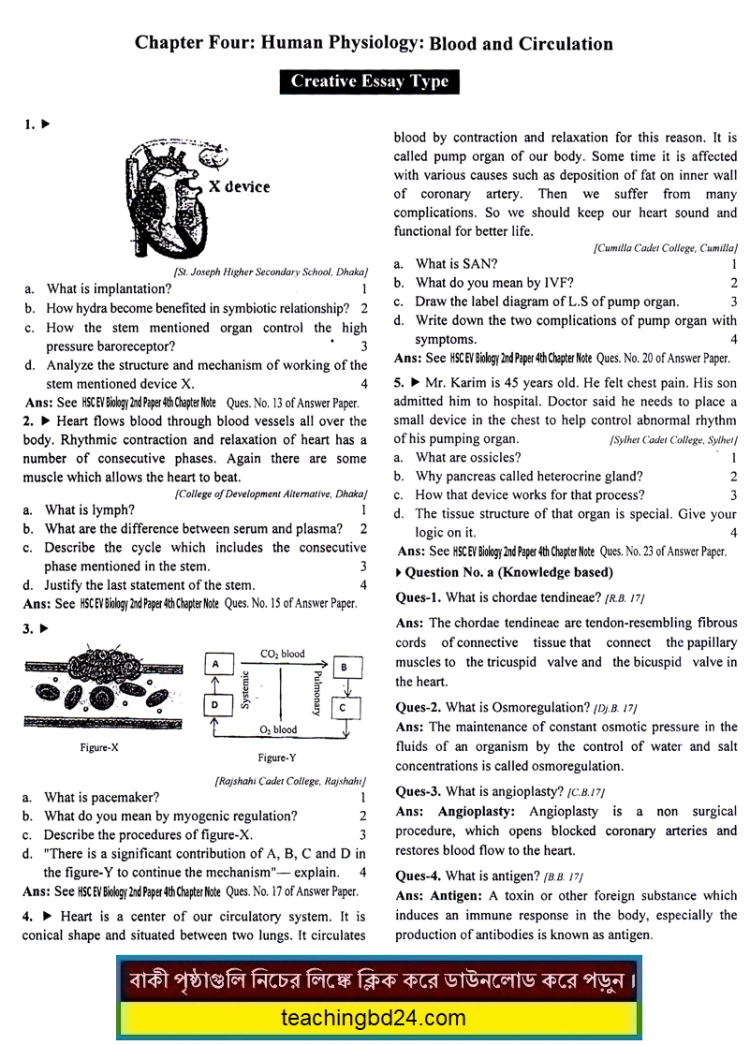EV HSC Biology II 4th Chapter MCQ Question Answer
EV HSC Biology II 4th Chapter MCQ Question Answer. Human Blood and Circulation. Blood is a body fluid in humans and other animals that delivers necessary substances such as nutrients and oxygen to the cells and transports metabolic waste products away from those same cells. In vertebrates, it is composed of blood cells suspended in blood plasma. Plasma, which constitutes 55% of blood fluid, is mostly water (92% by volume) and contains proteins, glucose, mineral ions, hormones, carbon dioxide (plasma being the main medium for excretory product transportation), and blood cells themselves. Albumin is the main protein in plasma, and it functions to regulate the colloidal osmotic pressure of blood.
The blood cells are mainly red blood cells (also called RBCs or erythrocytes), white blood cells (also called WBCs or leukocytes) and platelets (also called thrombocytes). The most abundant cells in vertebrate blood are red blood cells. These contain hemoglobin, an iron-containing protein, which facilitates oxygen transport by reversibly binding to this respiratory gas and greatly increasing its solubility in blood. In contrast, carbon dioxide is mostly transported extracellularly as bicarbonate ion transported in plasma.
Blood is a constantly circulating fluid providing the body with nutrition, oxygen, and waste removal. Blood is mostly liquid, with numerous cells and proteins suspended in it, making blood “thicker” than pure water. The average person has about 5 liters (more than a gallon) of blood. A liquid called plasma makes up about half of the content of blood. Plasma contains proteins that help blood to clot, transport substances through the blood, and perform other functions. Blood plasma also contains glucose and other dissolved nutrients.
EV HSC Biology II 4th Chapter MCQ Question Answer. Human Blood and Circulation

EV HSC Biology 2nd Paper MCQ Question With Answer

Biology is the natural science that studies life and living organisms, including their physical structure, chemical processes, molecular interactions, physiological mechanisms, development, and evolution. Botany, also called plant science(s), plant biology or phytology, is the science of plant life and a branch of biology.
The fields within biology are further divided based on the scale at which organisms are studied and the methods used to study them: biochemistry examines the fundamental chemistry of life; molecular biology studies the complex interactions of systems of biological molecules; cellular biology examines the basic building block of all life, the cell; physiology examines the physical and chemical functions of the tissues and organ systems of an organism, and ecology examines how various organisms interrelate.
A botanist, plant scientist or phytologist is a scientist who specializes in this field. Zoology is the scientific study of animals. This discipline can include animal anatomy, physiology, biochemistry, genetics, evolution, ecology, behavior, and conservation.
The proper function of human bodies is dependent on smaller structures, or organs, such as the heart or lungs. The tiny cells that make up these organs actually contain within them smaller structures called organelles. These organelles help the cells to perform their jobs. In cancer, changes to these organelles can cause the individual cells and ultimately the entire organism to have serious problems. To get a better understanding of how cells work, we will now spend some time examining some of these subcellular structures.
The organelles that we will discuss are involved in the information flow within cells and in energy production. In addition, we will look at a structure that gives cells their shape and allows them to reproduce themselves. All of the organelles and processes to be discussed have direct relevance to cancer because these are the cellular structures/activities that become disturbed in the disease.
The image below shows two living mouse cells. The mitochondria are colored red and the nuclei (with brightly stained chromosomes) are colored blue. The green colored region near the nuclei of the cells represents the Golgi apparatus, an organelle involved in the processing and packaging of molecules within the cell.
teachingbd24.com is such a website where you will get all kinds of necessary information regarding educational notes, suggestions and question patterns of schools, colleges, and madrasas. Particularly, you will get here special notes of physics that will be immensely useful to both students and teachers. The builder of the website is Mr. Md. Shah Jamal who has been serving for 32 years as an Assistant Professor of Physics at BAF Shaheen College Dhaka. He expects that this website will meet up all the needs of Bengali version learners /students. He has requested concerned students and teachers to spread this website home and abroad.
